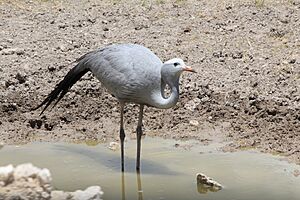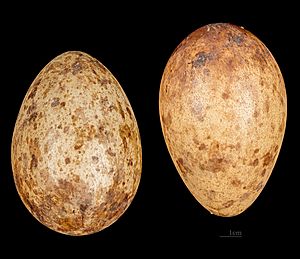Blue crane facts for kids
The blue crane (Grus paradisea), also known as the Stanley crane or paradise crane, is the national bird of South Africa. This beautiful bird is listed as Vulnerable by the IUCN, meaning its numbers are decreasing and it needs our help to survive.
Quick facts for kids Blue crane |
|
|---|---|
 |
|
| Conservation status | |
| Scientific classification | |
| Genus: |
Grus
|
| Species: |
paradisea
|
| Synonyms | |
|
|
Contents
What Does the Blue Crane Look Like?

The blue crane is a tall bird that lives on the ground. It's one of the smaller members of the crane family. These birds are usually about 1 to 1.2 meters (3 to 4 feet) tall. Their wings can spread out to about 1.8 to 2 meters (6 to 6.5 feet) wide. They weigh between 3.6 and 6.2 kilograms (8 to 13.5 pounds).
Blue cranes have a pale blue-gray color. Their head, neck, and the back of their neck are a bit darker. The top of their head is lighter, sometimes even whitish. Their bill is a mix of ochre (yellowish-brown) and grayish, with a hint of pink. One special thing about them is their long wingtip feathers that trail down to the ground. Unlike most cranes, they have a fairly large head and a thin neck. Young blue cranes look similar but are lighter in color. They have a tawny (light brownish-orange) head and don't have the long wing plumes yet.
Where Do Blue Cranes Live?
Blue cranes love dry, grassy areas. They often live in pastures on hills, in valleys, and on plains where there are a few scattered trees. When it's time to nest, they like places that have both dry land and wetlands nearby. However, they mostly find their food in dry areas.
These cranes move to different heights depending on the season. They usually nest in lower grasslands, about 1,300 to 2,000 meters (4,200 to 6,500 feet) high. Then, they move to lower areas for the winter. Even though they used to live in quiet places, blue cranes are now doing well in farm areas in the Western Cape. This is the only place where their numbers are growing. However, they still face dangers like poisoning in these areas.
How Do Blue Cranes Behave?
The blue crane lives in fewer places than any of the other 15 crane species. Even cranes with smaller populations can be found over a much wider area when they migrate. Blue cranes do migrate, mostly moving to different altitudes, but we don't know all the details about their journeys.
Blue cranes are somewhat social, but less so during their breeding season. In groups, there's a clear pecking order, with larger adult males being in charge. They live in the same areas as three other crane species, but we don't know much about how they interact with them. During nesting season, they can be very aggressive towards other animals. They might attack non-dangerous animals like cows, tortoises, plovers, and even sparrows. If people get too close to a nest, the male crane might even attack them, sometimes tearing clothes or causing scratches.
What Do Blue Cranes Eat?
Blue cranes find their food on the ground. They don't seem to eat much near wetlands. Most of their diet is made up of grasses and sedges. They eat many different types of these plants, depending on what's close to their nests. They also eat a lot of insects, especially large ones like grasshoppers.
Sometimes, they add small animals to their diet. These can include crabs, snails, frogs, small lizards, and snakes. This protein-rich food is often broken down and fed to their young chicks.
How Do Blue Cranes Raise Their Young?
Blue cranes have a very specific breeding season. They usually lay eggs between October and March. Pairs start to form in groups around October. This often begins with the male and female running in circles together. Then, the male performs a "dance" where he throws things into the air and jumps. Eventually, a male and female from the group seem to choose each other. They both join in the dance, throwing objects and jumping. After this dance, they usually mate about two weeks later.
Most of the time, blue cranes lay two eggs. Sometimes they lay one or three, but this is rare. Both the male and female take turns sitting on the eggs to keep them warm. The male often incubates at night. During the day, he usually guards the nest while the female incubates. The eggs hatch after about 30 days.
The young chicks can walk after just two days and can swim well very soon after that. Their mothers mostly feed them by bringing up food from their stomachs. The chicks learn to fly when they are about 3 to 5 months old. The parents continue to care for their young until the next breeding season. At that point, the young cranes are chased away by their parents to find their own way.
Why Are Blue Cranes Declining?
Even though about 26,000 blue cranes still exist, their population started to drop suddenly around 1980. This is why they are now classified as vulnerable.
In the last 20 years, blue cranes have mostly disappeared from the Eastern Cape, Lesotho, and Swaziland. Their numbers in the northern Free State, Limpopo, Gauteng, Mpumalanga, and North West Province have gone down by as much as 90%. Most of the remaining blue cranes live in eastern and southern South Africa. There's also a small group in the Etosha Pan in northern Namibia. Sometimes, a few breeding pairs are found in five other nearby countries.
The main reasons for the sudden drop in blue crane numbers are:
- More people living in their habitats.
- Grasslands being turned into tree farms.
- Poisoning: This can be done on purpose to protect crops, or by accident from baits meant for other animals, or from crop dusting chemicals.
The South African government has made laws to better protect the blue crane. Other efforts to save them include research, managing their habitats, educating people, and getting help from private landowners. The blue crane is also protected by an international agreement called the Agreement on the Conservation of African-Eurasian Migratory Waterbirds (AEWA).
Images for kids
-
A blue crane at the International Crane Foundation
See also
 In Spanish: Grus paradisea para niños
In Spanish: Grus paradisea para niños




